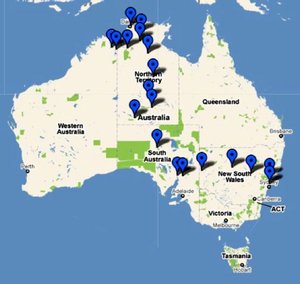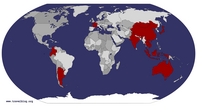Advertisement

 Our journey ...
Our journey ...
... took us right across Australia ...I'D WANTED to make this journey for over forty years. Now I’ve done it, along with friends Phil, Mike, Monica. We took less than three weeks and covered six thousand kilometers to drive one way. That’s a rate of 2000km per week. We crossed Australia from Darwin, NT, to the Central Coast, NSW.
Along the way, I met a lot of stories. There was that of our own trip, and we learned about those of the geologists and biologists who studied the land, those of the Aboriginal people and the bushies who lived there. In all these stories the land plays a major role: not the land as setting, the land as protagonist. Wet or dry, vegetated or barren, red rock and red dust, it was with us all the way. After all, it was there first.
Australia is the oldest continent. Once attached to Gondwanaland and Southern Asia, it moved south over aeons. Mountain ranged were formed and eroded. Ice ages came and went. An inland sea formed and evaporated. Sedimentary rocks, laid down in that sea, dried and were subject to further folding and faulting, to erosion, erosion, and more erosion. Flora and fauna, isolated from the

 Journey in a Nutshell
Journey in a Nutshell
It started in the wet of The Top End ...rest of the world, changed slowly and adapted to extremes of temperature and of water supply.
We photographed outrageous landforms famous and unknown, plants adapted to long droughts and occasional downpours, and as many iconic Australian animals as we saw. According to the Aboriginal People, at first there was nothing on the earth; it was flat and empty. Then the ancestral spirits came and made the natural features. One of them - the Creator Spirit - had dilly bags: one holding men, one with women, one with plants and trees, one with animals, and one with language and culture. She went to all the different places and, in each place, took a man and a women out of the bags, along with some plants and animals; then she gave them their language and culture. Culture included laws and traditions and knowledge of how to make artifacts and how to care for the land in that place. The spirits live on in the animals and all the other things that were created, and so the material world is imbued with the spiritual.
Artwork becomes spiritual work. It can record events. It can influence future events. As when a

 Journey in a Nutshell
Journey in a Nutshell
... took us past Karlu Karlu (the Devil's Marbles) ...hunter catches a huge fish and draws a big fish on a rock nearby, thus ensuring there’ll be another big fish at the place when he returns. Art is also used to illustrate stories as they are told, myths and didactic tales.
So a woman can say (as I read in the Darwin Art Gallery), “My dreaming is in the weaving that I make.”
Albert Namintjira told his young family, “You have to paint to hold the country together.”
Robert, one of our guides in Kakadu, told us, “White Man’s laws change; our laws can never change.”
The creation stories provide a spiritual interpretation of the whole of life.
We photographed traditional rock painting galleries in Kakadu, learned about the spiritual significance of Uluru (Ayer’s Rock), felt the spiritual power of the rocks at Kata Tjuta (the Olgas), and studied displays of art and culture in Darwin, Kakadu, and Alice Springs. Most of the land we covered was blossoming; it was receiving the first significant rain in decades. Very, very recently, strangers came to the North and to the Centre. The Australians saw their white skins and thought they might be spirit ancestors

 Journey in a Nutshell
Journey in a Nutshell
... delivering us to Uluru ...returning. The newcomers saw the tools used by the Australians and concluded they were locked in the Stone Age.
The newcomers contended with isolation, lack of supplies, loneliness, acres of water during the monsoons and an inability to relate with the Australians. It seems there could have been space given for them to live alongside each other, but no space for strangers who came to appropriate, to be unsharing. The newcomers’ belief that they were conquering the land could not have been more at odds with Aboriginal Australian commitment to honouring and caring for the land.
They brough buffalo from Timor in the 1820, releasing 50 head in 1845, and later in the century drove cattle across from Queensland. They ran a telegraph line north-south, over 3200km of desert in two and a half years, cutting communication times with London, in 1872, from weeks to hours. In the 1960s they constructed the huge Ord River Irrigation Scheme. For years they produced watermelons here; now they are farming Indian Sandalwood. We passed the Ranger Uranium mine, visited the Ord River Irrigation Scheme, and went underground in the opal mining town of Coober Pedy. The newcomers may have found the

 Journey in a Nutshell
Journey in a Nutshell
... through desert ...country inhospitable, but they dug in. Literally.
We photographed a number of literary relics: a replica of Elsie Station (We of the Never Never by Mrs Aneas Gunn), the - relocated - Argyle Station as well as Patsy Durak’s original store at Wyndham (Kings in Grass Castles by Mary Durak) and the Daley Waters pub (Two at Daley Waters by Elizabeth George). We snapped all sorts of human activities that we saw … and we snapped ourselves … Our Journey
We gathered in a cheap Darwin motel,
the Capricornia, on Saturday night. On Sunday morning we drove to Kakadu and stayed two nights in dormitories at
Gagudju Lodge. We made trips to
Ubirr Rock and
Nourlangie art sites.
On Wednesday morning we went through Katherine and headed for Kunanurra in WA. We spent three nights in a cabin in the
Town Caravan Park, exploring the East Kimberlies and the port at Wynham. Wyndham was a delight. An old settlers’ port, the doorway to the Kimberleys, and the home of a working crocodile farm where a keen young attendant and ferocious old crocks vie to be the star attraction (
Wyndham Crocodile Farm).
Back to Katherine and two nights in a cabin at
Knotts Crossing Resort,

 Journey in a Nutshell
Journey in a Nutshell
... and lush growth ...with a cruise on the Gorge. A long drive south, with dancing in the rain in Tennant Creek. That night camping beside the
Devil’s Marbles (National Park campsite, $3 per person) and waking to see these giant stones in red dawn light.
We spent three nights in Alice Springs (
Toddy’s Backpackers’ Resort) . There’s a lot to see in that town, and I rushed around some of it while the others had a half day’s rest. Then off to Uluru and Kata Tjuta (a cabin in the
Ayers Rock Resort Campground for two nights). Like Kakadu, they offer national park, cultural displays, and tourist enclave, but it was a very different experience: different landscapes, different peoples. The best moment was lying down in a gorge in Kata-Tjuta (the Olgas) and hearing the cliff speak to me.
Another long day’s drive, ending in an underground stay in a Coober Pedy bunkhouse at the
Umoona Opal Mine, with dinner in the Greek restaurant that was used by Mel Gibson and Guy Pierce, filming there at different times. Then a morning tour of an opal mine. No time to sample the variety of eccentric underground homes, or to the see the underground Catholic and Orthodox churches.
From Coober

 Journey in a Nutshell
Journey in a Nutshell
... in deeper than we intended.Pedy, with it’s piles of rock tailings to the Flinders Ranges, with their monumental river red gums. We spent two nights camping near
Wilpena Pound, walking and relaxing before the Great Dash Home. The next day we started early, lunched in
Broken Hill and reached
Cobar in time for dinner at the Bowling Club. The next day we had morning tea in
Dubbo, lunch in the
Hunter Valley, and dinner in
Pearl Beach. Just two-and-a-half weeks after we left Darwin.
It hadn’t been as difficult as I’d expected. The highways were simple two-way roads, but they were sealed all the way, and smooth. They didn’t carry much traffic and the speed limit in the NT and WA was 130km an hour. We only got bogged once, and that was on a side road.
More photos below the comments section.
Advertisement
Tot: 0.089s; Tpl: 0.013s; cc: 8; qc: 24; dbt: 0.0341s; 1; m:domysql w:travelblog (10.17.0.13); sld: 1;
; mem: 1.1mb


























Guenter
non-member comment
Fabulous
Lovely pix, and comments. Must do the Kimberleys before I die...